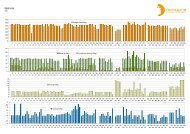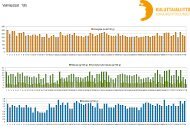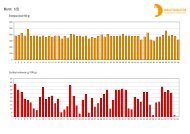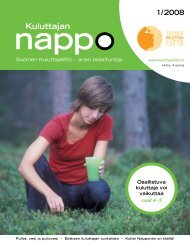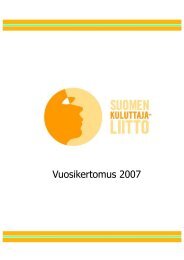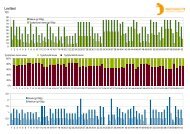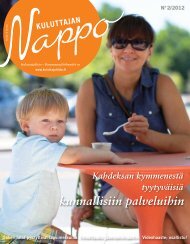Marketing unhealthy food to children in Asia Pacific - Consumers ...
Marketing unhealthy food to children in Asia Pacific - Consumers ...
Marketing unhealthy food to children in Asia Pacific - Consumers ...
- No tags were found...
Create successful ePaper yourself
Turn your PDF publications into a flip-book with our unique Google optimized e-Paper software.
Executive summaryThe World Health Organization (WHO) estimates that2.3 billion people, almost one third of the globalpopulation, will be overweight by 2015. While everycont<strong>in</strong>ent has <strong>to</strong> face up <strong>to</strong> the health consequences andeconomic repercussions of this preventable catastrophe,<strong>Asia</strong> is arguably fac<strong>in</strong>g the greatest challenge.Overweight and obesity rates are ris<strong>in</strong>g faster <strong>in</strong> SouthEast <strong>Asia</strong> than anywhere else <strong>in</strong> the world. With apredicted 27.5% rise <strong>in</strong> overweight <strong>children</strong> <strong>in</strong> the regionbetween 2005 and 2010 1 , every contribut<strong>in</strong>g fac<strong>to</strong>rneeds <strong>to</strong> be urgently addressed. This report comes at ahighly significant time.While personal responsibility for ma<strong>in</strong>ta<strong>in</strong><strong>in</strong>g a healthyand active lifestyle is important, governments and theconsumer <strong>in</strong>dustries must also be held <strong>to</strong> account for thesignificant role they need <strong>to</strong> play. None more so than <strong>in</strong>their duty <strong>to</strong> young people.As other em<strong>in</strong>ent studies have shown, an overweight orobese child is far more susceptible <strong>to</strong> be obese and sufferfrom related health issues later <strong>in</strong> life. Action now canprevent immense costs <strong>in</strong> the future - for <strong>in</strong>dividuals andsociety as a whole.However, as this study will demonstrate, the pervasivemarket<strong>in</strong>g of <strong>unhealthy</strong> <strong>food</strong> <strong>to</strong> <strong>children</strong> by the world’slead<strong>in</strong>g <strong>food</strong> and soft dr<strong>in</strong>k manufacturers threatens <strong>to</strong>underm<strong>in</strong>e efforts <strong>to</strong> tackle obesity. From highlysophisticated Internet promotions, <strong>to</strong> the direct appeal ofcelebrity and car<strong>to</strong>on character endorsements; globalbrands are <strong>in</strong>fluenc<strong>in</strong>g the <strong>food</strong> preferences of pre-teenand teenage consumers and underm<strong>in</strong><strong>in</strong>g any positivemessages that young people are receiv<strong>in</strong>g about healthylifestyles.As detailed <strong>in</strong> this report, the scale and reach of thismarket<strong>in</strong>g effort is as<strong>to</strong>nish<strong>in</strong>g. In Malaysia, for <strong>in</strong>stance,KFC’s Chicky Club (a promotion <strong>to</strong>ol for the fast <strong>food</strong>cha<strong>in</strong>’s kids meal) is now the biggest kids club <strong>in</strong> thecountry.Equally, the levels of <strong>unhealthy</strong> <strong>in</strong>gredients <strong>in</strong> popularproducts <strong>in</strong> the region should not be underestimated.Accord<strong>in</strong>g <strong>to</strong> the standard used <strong>in</strong> this report, sugar levelsare considered <strong>to</strong> be high if there is 15g per 100g, yet <strong>in</strong>some countries we found Kellogg’s Frostie’s thatconta<strong>in</strong>ed over 40g per 100g. Nestlé’s MILO Energy Barconta<strong>in</strong>s over 25g of saturated fat per 100g, yet anyth<strong>in</strong>gover 5g is considered <strong>to</strong> be a high level.This report shows that, <strong>to</strong> date, the response fromgovernments and companies <strong>in</strong> this region falls far shor<strong>to</strong>f what many believe is needed. Malaysia and Thailandwere found <strong>to</strong> have the strongest regulation <strong>in</strong> theregion, however there are still plenty of worry<strong>in</strong>gexamples of market<strong>in</strong>g <strong>to</strong> be found <strong>in</strong> these countries.Other countries have even further <strong>to</strong> go, with a completeabsence of on-package nutritional <strong>in</strong>formation <strong>in</strong> India,<strong>to</strong> near non-existent laws <strong>in</strong> Nepal.This problem, and the fight aga<strong>in</strong>st it, is a global one.<strong>Consumers</strong> International (CI), our national memberorganisations and our allies <strong>in</strong> the health sec<strong>to</strong>r havebeen lead<strong>in</strong>g the call for a global ban on the market<strong>in</strong>gof <strong>unhealthy</strong> <strong>food</strong> <strong>to</strong> <strong>children</strong> through the WHO. Whilesome global <strong>food</strong> and soft dr<strong>in</strong>k companies have madelimited national, regional and <strong>in</strong>ternational ‘pledges’ <strong>to</strong>curtail their market<strong>in</strong>g, many are half-hearted,<strong>in</strong>consistent efforts <strong>to</strong> deflect the real commitmentsneeded globally, across the entire sec<strong>to</strong>r.It is time for governments and <strong>in</strong>dustry <strong>to</strong> accept theargument that a global standard for the regulation of<strong>food</strong> market<strong>in</strong>g <strong>to</strong> <strong>children</strong> would give companies clarityand consistency, as well as the best possible <strong>in</strong>centive <strong>to</strong>develop healthy products for <strong>children</strong>.Executive summary7




